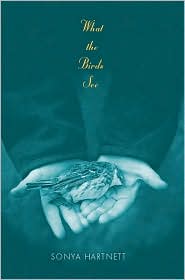
WHAT THE BIRDS SEE
by Sonya Hartnett
PUBLICATION INFORMATION:
Hartnet, S. (2003). What the birds see. Cambridge, MA: Candlewick Press.
AWARDS:
While this particular novel has not been honored with awards, Hartnett has received many awards in both Australia and the U.S. for several of her other novels. Most notably Thursday's Child, which I just started and will read over the weekend.
SYNOPSIS
Hartnet employs a sliding omniscient narrator, present tense narration, and a highly poetic sensibility in this novel. Adrian, a nine-year-old boy, is the novel’s main character. Through back-story, readers come to understand that Adrian has been removed from his mother’s custody by authorities because of her instability and failure to provide. Once he is removed from his mother's custody, he no longer has opportunities to see his mother; and, in fact, does not even know where she lives. After he was taken from his mother, Adrian lived with his father, who later decides he would rather not be tied down with the responsibilities of raising a child. When the novel begins, Adrian is currently residing with his grandmother and 25-year-old uncle, Rory. Based on an overheard conversation between his father and grandmother, Aidan views himself as worthless and dull. He has only one friend at school who abandons him for someone more popular. The emotional climax occurs when Adrian overhears a conversation between his grandmother, uncle, and aunt, in which the state that they do not really want to raise Adrian. The novel ends tragically, and students will most likely need some emotional support from teachers when reading this very tough yet beautiful book.
EVALUATION:
Wow, this book's language is magical. I really admire her desriptions and her very spare and emotionally restrained prose. She is a poet working in fiction medium. She is wonderful at capturing the significance of small moments. I do, however, have a few reservations about some aspects of this novel. For one, I think Adrian, the main character, seems much older than 9--Based on the emotional, cognitive, and developmental traits depicted in the novel, he seems to be an emerging adolescent. So I would argue that he seems to be about 11 or 12 years old. There are also a few times when I felt the omniscent narrator broke down or did not quite work. Also, the ending is quite harsh and maybe a little over the top. It definetly requires some debriefing time.
CLASSROOM APPLICATIONS:
I think this book could be usful in a writing workshop classroom. Teachers could use it for both poetry or fiction/creative nonfiction. I think it could be used for lessons on decription, point of view (for upper-level students), mood, and tone. Teachers could also use snippets from this text as a means of demonstrating the art of showing verses telling. I would love to read portions of this book aloud. I don't think I would use it as a whole-class read, but it could work well in small groups. I think it would be wise to have some adult read this novel along with a students who selected this book as an individual-choice read. The book presents some really tough content.
AGE LEVEL:
Although the story focuses on a nine-year-old boy, the reading level and content are for advanced readers. This book might work okay as a read-aloud for younger students. However, the severity of the ending may require the teacher to offer some emotional support for students.




No comments:
Post a Comment